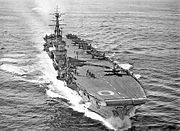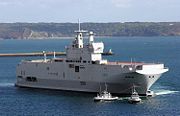Amphibious assault ship
| Amphibious assault ship | |
|---|---|
 |
|
| Six of the U.S. Navy's assault ships in formation; lead ship and first ship to port are Tarawa-class, all others are Wasp-class |
An amphibious assault ship (also referred to as an amphibious assault carrier or commando carrier) is a type of helicopter carrier employed to land and support ground forces on enemy territory by an amphibious assault.
While often resembling aircraft carriers, the role of an amphibious assault ship is fundamentally different: its aviation facilities have the primary role of hosting helicopters to support forces ashore rather than to support strike aircraft. However, they are capable of serving in the sea-control role, embarking aircraft like Harrier fighters and ASW helicopters. Most of these ships can also carry or support landing craft; such as air-cushioned landing craft or LCUs.
The largest fleet of these types is operated by the United States Navy, including the Tarawa class dating back to the 1970s and the newer and larger Wasp class ships that debuted in 1989. Amphibious assault ships are also operated by the French Marine Nationale, the Republic of Korea Navy, the Spanish Armada Española, and the British Royal Navy.
Contents |
History

The two nations that have made by far the most amphibious assaults during the past century are the United States and the United Kingdom. From the great assaults of World War II to the recent attack on the Al-Faw Peninsula in Iraq, both countries have been at the forefront of developing amphibious assault doctrine and shipping.
World War II
In the Pacific theater of World War II, the escort carriers would often escort the landing ships and troop carriers during the island-hopping campaign. In this role, they would provide air cover for the troopships as well as fly the first wave of attacks on the beach fortifications in amphibious landing operations. On occasion they would even escort the large carriers, serving as emergency airstrips and providing fighter cover for their larger sisters while these were busy readying or refueling their own planes. In addition to this, they would also transport aircraft and spare parts from the US to the remote island airstrips.
Post-World War II
Despite all the progress that was seen during World War II, there were still fundamental limitations in the types of coastline that were suitable for assault. Beaches had to be relatively free of obstacles, and have the right tidal conditions and the correct slope. However, the development of the helicopter fundamentally changed the equation. The first use of helicopters in an amphibious assault came during the Anglo-French-Israeli invasion of Egypt in 1956 (the Suez War). Two British light fleet carriers, HM Ships Ocean and Theseus, were quickly converted to carry troops and helicopters and were used to perform a battalion-size airborne assault.

The techniques were developed further by American forces during the Vietnam War and refined during training exercises. The modern amphibious assault can take place at virtually any point of the coast, making defending against them extremely difficult.
Most early amphibious assault ships were converted from small aircraft carriers. As well as the two Colossus class light aircraft carriers converted for use in the Suez War, the British Royal Navy converted the Centaur class carriers Albion and Bulwark into "commando carriers" during the 1950s.[1] Sister ship HMS Hermes was also converted to a commando carrier in the early 1970s, but was restored to aircraft carrier operations before the end of the 1970s. The United States Navy used three Essex class aircraft carriers; US Ships Boxer, Princeton, and Valley Forge, and the Casablanca class escort carrier USS Thetis Bay as the basis of their amphibious assault fleet, before constructing the five Iwo Jima class ships specifically for the Landing Platform Helicopter role.
Later amphibious assault craft were constructed for the role. The United States Navy constructed the Tarawa class of five Landing Helicopter Assault ships, which began to enter service from the late 1970s, and the Wasp class of eight Landing Helicopter Dock ships, the first of which was commissioned in 1989. The United States Navy is also designing a new class of assault ships: the first America class ship is predicted to enter service in 2013.
The first British ship to be constructed specifically for the amphibious assault role was HMS Ocean, which was commissioned into the Royal Navy in 1998. Other nations have built amphibious assault ships; the French Mistral class, South Korea's ROKS Dokdo, and Spain's Juan Carlos I (L61) are all currently active, while Australia is planning to build two Canberra class ships based on the Spanish design.
Design

Due to their aircraft carrier heritage, all amphibious assault ships resemble aircraft carriers in design. The flight deck is used to operate helicopters for landing troops and supplies and Harrier Jump Jets to provide air support to landing operations. STOL aircraft such as the OV-10 were sometimes deployed on and were able to perform short takeoffs and landings on large deck amphibious assault ships without needing catapults or arresting wires, although for safety and clearance reasons the latter was most often not permitted.[2] Landing craft are also carried, either on deck-mounted davits, or in an internal well deck.
List of types
- Landing Helicopter Assault (LHA)
- Tarawa class
- America class
- Landing Helicopter Dock (LHD)
- Wasp class
- Mistral class
- Dokdo class
- Juan Carlos I
- Landing Platform Helicopter (LPH)
- Iwo Jima class
- HMS Ocean




- Marine Nationale
- Mistral class - LHD
- Mistral (L9013)
- Tonnerre (L9014)
- Mistral class - LHD
- Republic of Korea Navy
- Dokdo class - ROKS Dokdo - LHD
- Spanish Navy
- Juan Carlos I (L61) - LHD
- Royal Navy
- HMS Ocean (L12) - LPH
- United States Navy
- Wasp class - LHD
- USS Wasp (LHD-1)
- USS Essex (LHD-2)
- USS Kearsarge (LHD-3)
- USS Boxer (LHD-4)
- USS Bataan (LHD-5)
- USS Bonhomme Richard (LHD-6)
- USS Iwo Jima (LHD-7)
- USS Makin Island (LHD-8)
- Tarawa class - LHA
- USS Tarawa (LHA-1)
- USS Nassau (LHA-4)
- USS Peleliu (LHA-5)
- America class - LHA
- USS America (LHA-6) (under construction)
- Wasp class - LHD
See also
- Amphibious assault submarine
- Amphibious warfare ship
- Escort carrier
- Helicopter carrier
- List of amphibious warfare ships
References
- ↑ "HMS OCEAN Light Fleet Carrier". Aircraft Carrier Database. Fleet Air Arm Archive.
- ↑ Polmar, Norman (2004). The Naval Institute Guide To The Ships And Aircraft Of The U.S. Fleet. Annapolis, Maryland: Naval Institute Press. p. 392. ISBN 1591146852.